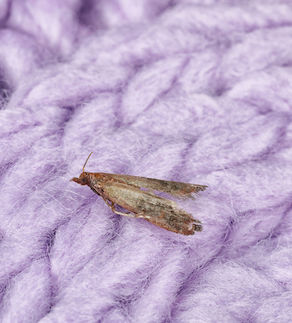How to Get Rid of Clothes Moths for Good
When most people think of moths, they think of small, winged insects that are attracted to bright lights. However, there’s much more variety to this pest type than that. If certain kinds of moths sneak into your home, there’s a chance that when looking for food, they can get into your pantry products. That’s not the only place they’ll find food, though. Many moths feed on animal fibers, which means you may also find them infesting your closet. Here’s what you need to know about clothing moths.
What Are Clothes Moths?
Ever have a hole in your favorite wool coat and wonder where it came from? Clothes moths are types of moths that infest garments, carpeting and other textile products, using them as their main source of food. These are some things to know about clothes moths:
- They don’t like light, and choose to infest cloth products that are stored in dark places, like closets, wardrobes and chests.
- Fully grown moths do not feed on clothing, but their larvae do. Clothes moths lay their tiny, pinhead-sized eggs on garments and other cloth materials. Once these eggs hatch into moth larvae, the larvae then begin to feed on the abundant clothing fibers around them. These larvae are usually creamy white in color and can be up to ½ inch long.
- There are two main varieties of clothes moths that you may find in your home:
- Casemaking moths: The casemaking moth encloses itself within a silken, tube-shaped case that it drags around with it. These “cases” usually contain bits of the clothing fibers that these moths feed on.
- Webbing moths: The webbing moth is known for the silken weblike substance that it spins as it eats, leaving tubes and patches of it on the garment it’s consuming.
- Clothes moths consume natural, animal-based fibers that contain the protein keratin, such as silk, fur, wool, feathers, felt and leather. Unfortunately, this means they often infest and damage more expensive articles of clothing because they will not eat the synthetic fibers of cheaper garments. In nature, clothes moth larvae are laid in and will eat the fibers found in bird and squirrel nests, along with discarded or dead fur or feathers.
- Closets aren’t the only places that clothes moths will infest. They can also be found in basements, attics and wall cavities where old garments and rugs are stored and where animals build their nests when hiding out in your home. Additionally, you may find them in furniture and upholstery if it’s made of natural fibers.
How to Prevent Clothes Moths
The first step to preventing clothes moths is to carefully clean all coats, blankets or other natural fiber textile products before storing them to make sure they don’t have moth eggs on them. This can include dry-cleaning, running them through the wash and carefully inspecting and brushing them to ensure there are no eggs or larvae attached. Pay close attention to areas such as under the collar, inside the sleeves and the tucked areas of seams. Then, store your clothes in tight-fitting and sealable plastic bags before hanging them up or putting them in boxes.
How to Get Rid of Clothes Moths
Many people also turn to moth balls, flakes, or crystals that contain naphthalene or paradichlorobenzene. These chemicals will deter moths from laying their eggs, but they are also hazardous to children and pets. Therefore, it’s best to carefully control these substances by only using the recommended amount and by keeping them within the sealed bags of these garments.
Since many of the moth traps and insecticides available can also be volatile and dangerous for home use, it’s best to contact professional pest control technicians to inspect your home for pests and eradicate them. At Alexandria Pest Services, we offer free inspections to help you determine where pests like clothes moths are hiding and create a plan to get rid of them. If you need assistance with such pests, contact us today!
How Alexandria Pest Services Can Help
Have a termite, pest, rodent, or moth problem in your home, or are you interested in performing proactive home maintenance? At Alexandria Pest Services, our trained professionals will analyze your pest control needs and come up with a personalized plan for your household. Our team of expert technicians will provide a free inspection and work to create a plan to eliminate your pests. At Alexandria Pest Services, we help homeowners just like you get rid of pests in their homes all year round. If you find that you are having a problem with insects or pests, and need an exterminator, call Alexandria Pest Services at 703-923-0925 to schedule a professional evaluation. We can help you get rid of these invaders in your home or office!
We hope you and your loved ones stay well and healthy during this time. We are open and following all CDC regulations. Please call us today for all of your pest control needs!





